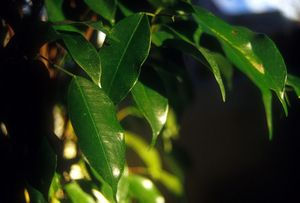I don’t know what the statistics may be–but it’s possible that one out of every three homes decorated with a few plants would have one of three of the most common varieties of a Ficus plant there. Chances are, too, that if you talked to the owner of a Ficus plant, he or she would probably know little about its background or even how to care for it. In those cases, you’ll probably hear your friend who owns one sounding frustrated as to why their Ficus plant died on them. In other rare cases, they may have a Ficus plant that lasts for years–yet the owners somehow get away with not giving it the best possible care it could get. You can put my family into that latter category.
Miraculously, my mother has had a Ficus Benjamin plant (the most common variety with the oval-shaped leaves) for close to twenty years–despite not doing every little thing that’s typically required of it to keep it healthy. And yet it’s still thriving–if ten times bigger than it was just ten years ago. You could say that because my mom has always had a unique Green Thumb in getting plants to grow in places they normally wouldn’t. Nonetheless, when it came to getting a Ficus Benjamin plant way back when–we didn’t buy a large tome on how to care for one as experts in these plants recommend you do (mainly because they’ve written the book and want a few bucks from you). It’s been a bit of a self-learning process in how to care for it. But while I wouldn’t necessarily recommend everybody doing that–there are a few tips on care you should know before buying a Ficus plant.
As with the mysterious nature of plants, too, I recommend a few other alternative aspects of care that I’ve noticed make a huge difference in not only Ficus plants–but all plants…
Ficus plants need more light than water...
One of the fatal flaws of those who own Ficus plants is that people think it needs to be watered as much as other plants in the room. Because the plant comes from tropical regions (the Ficus Benjamin, particularly, comes from Malaysia) over-watering can cause it to literally drown. But lighting is one of the most important aspects to keep one of these plants happy. It’s essential, if you’re keeping one inside your home, to keep one by a large window where plenty of sunlight comes in. However, when the position of the sun changes during late fall/early winter–your Ficus Benjamin might get a little worried that something isn’t right.
Yes, this is one of those highly sensitive plants that respond dramatically to its environment. When the nuances of light suddenly changes from what the Ficus plant was previously used to–it’ll start shedding leaves in protest. This process even confused my family when we first started noticing leaves turning yellow and shedding to the point where it would leave ugly-looking, empty branches. Most people unaware of the plant’s emotions (sure, I’m not afraid to use that word) will quickly assume that the plant is dying. The good news for you is–that isn’t true at all.
The dropping of leaves (turning yellow before they drop) is just a sign that the plant’s comfort zone has been changed and it’s getting acclimated to something new. This usually happens if you’ve moved it to another location or after the trauma of a move. In some cases, it’ll happen while it’s sitting in the same spot without any seeming physical disturbance. The most likely reason it does it in those scenarios is because of a change in seasons (usually going from warmer to colder weather)–or because the sun direction from the window has changed due to the seasonal solstice. This scenario happens to my family’s Ficus plant annually. And, every year, it seems to look exactly like it’s slowly dying–with the thought it truly is after twenty years of surviving in the same spot.
It may look kind of bare for a while, but just keep making sure the plant gets light and it’ll re-adjust itself to the seasonal change of winter. Typically, it’ll drop the leaves anywhere between October-December when the dramatic temperature and sun shifts happen as we head into the winter season. By Christmastime–it’ll usually have new leaves grown in again and look fairly healthy.
Keep in mind that a Ficus plant has sensitive leaves (yeah, it’s the most sensitive plant in the horticultural universe) and can have its leaves burned if direct sunlight hits it through a window. Make sure it gets light–but not a direct, intense light.
What horticulturists say to do for Ficus plants that may not be absolutely necessary…
Some horticulturists will tell you to pamper your Ficus plant by cleaning off its leaves–considering the leaves respond sensitively to the surroundings and need to be clear to keep photosynthesis going. They’ll even tell you to spray the leaves with lukewarm water on occasion to keep a sense of subtle moisture going for the plant that it needs during the winter. It’s true, too, that those yellow leaves it gets sometimes means it has an iron deficiency that can be amended with liquid iron and warm water. But most people would laugh when hearing that you have to polish the leaves of the Ficus in order to keep it happy.
For the record, I don’t think my family has ever polished the leaves (or the equivalent of a plant manicure) of our Ficus Benjamin. Maybe it’s because it resides in a spot where dust and dirt can’t get on the leaves. Whatever the case, we’ve never sprayed it with warm water, cleaned the leaves or even given it fertilizer as other horticulturists recommend around the time it starts shedding leaves in the winter.
Because these types of Ficus plants can grow overtly large (my family’s has)–sometimes it becomes root-bound and needs a transferal to another pot. My family has never done that either with the plant being in the same pot from the beginning.
Consider my family’s Ficus something unusual. But I have my theories why–and it goes beyond the usual care for sensitive plants...
A Ficus plant’s interesting response to stimuli…
This particular family Ficus has always been in a spot that gets a lot of stimuli from talking people, a nearby piano and even a large-screen TV. It’s always been interesting to me that when I played the piano near the plant, a couple of days later would reveal the Ficus leaning slightly to the right toward direction of the piano. Conversely, the louder more chaotic sounds from the nearby big-screen TV to its left made it appear that its sensitive leaves were recoiling and turning the other direction. And when people had been standing near it during parties while gabbing up a storm–you could see the leaves and a few branches jutting outward a day or two later.
Of course, that seems to be a well-documented case with all plants exposed to pleasing sounds and human interaction. I don’t ever recall seeing such a fast response to nearby stimuli with any other plants my family have owned. The results in the others were much more subtle.
Perhaps you should try your own experiments if you ever buy a Ficus Benjamin–though you’ll probably notice right away how sensitive they are to your surrounding environment. You really shouldn’t expect this plant (or any plant for that matter) to survive for years if you have a lot of chaotic surroundings or you play Death Metal daily on the nearby stereo.
In the proverbial plant timeline–the Ficus plant will be with you the longest if you have a positive environment to go with it. Its desire of good music, lots of chatty people and a window with access to sunshine almost makes the Ficus plant about as human as we are…



